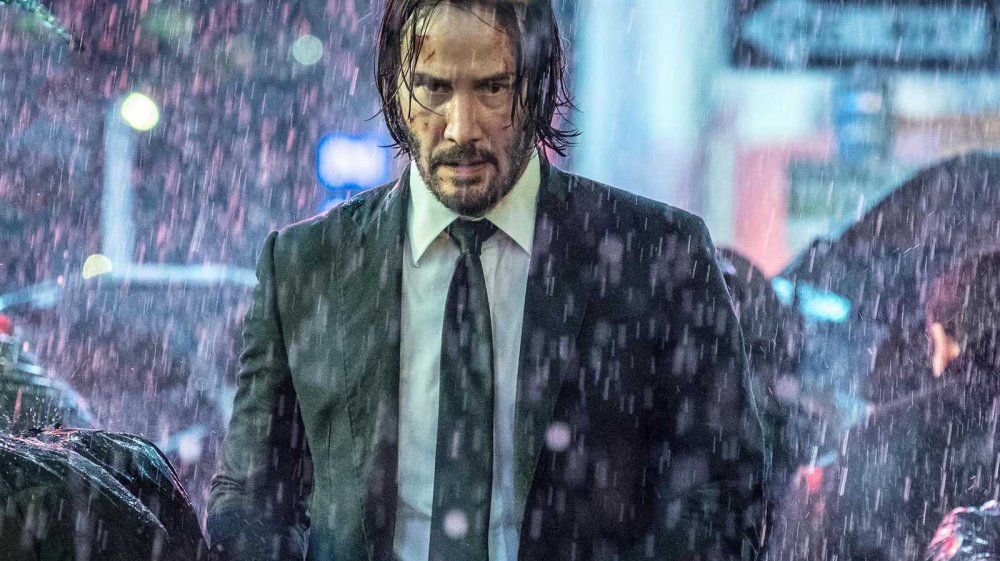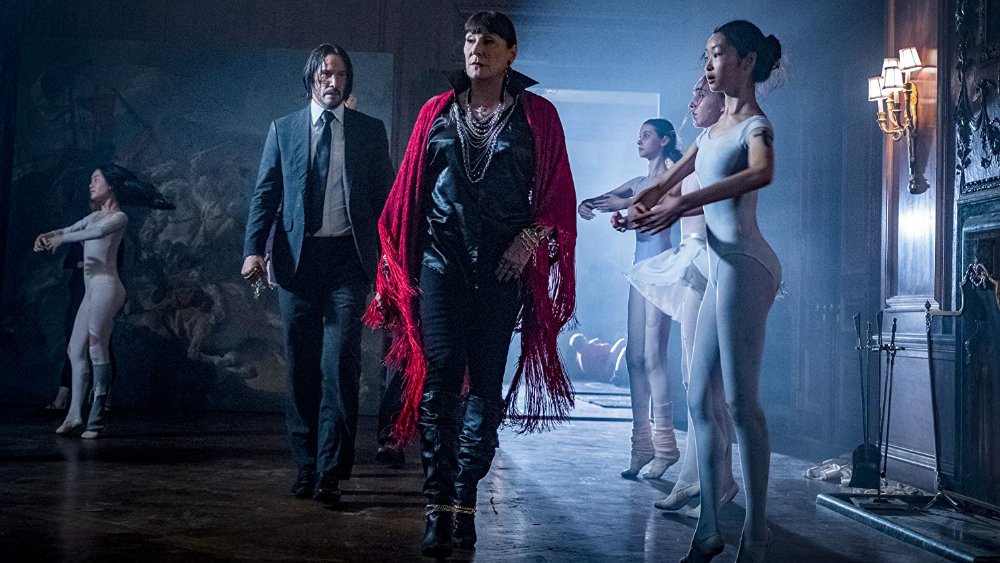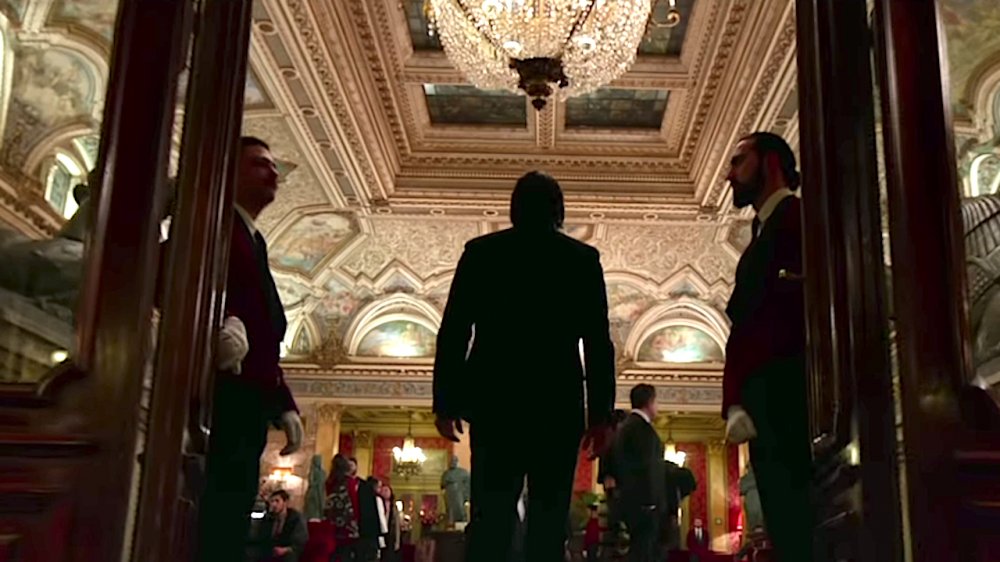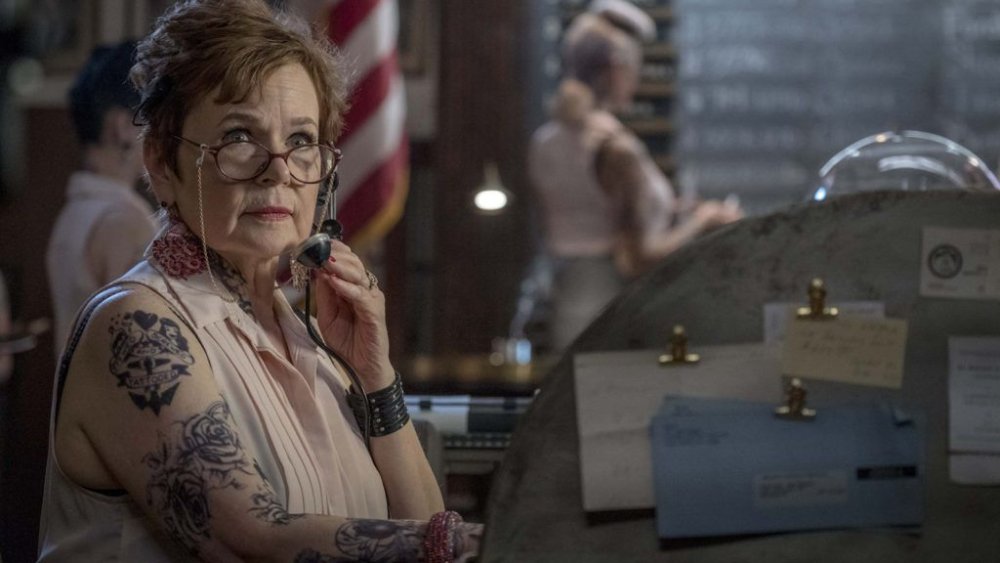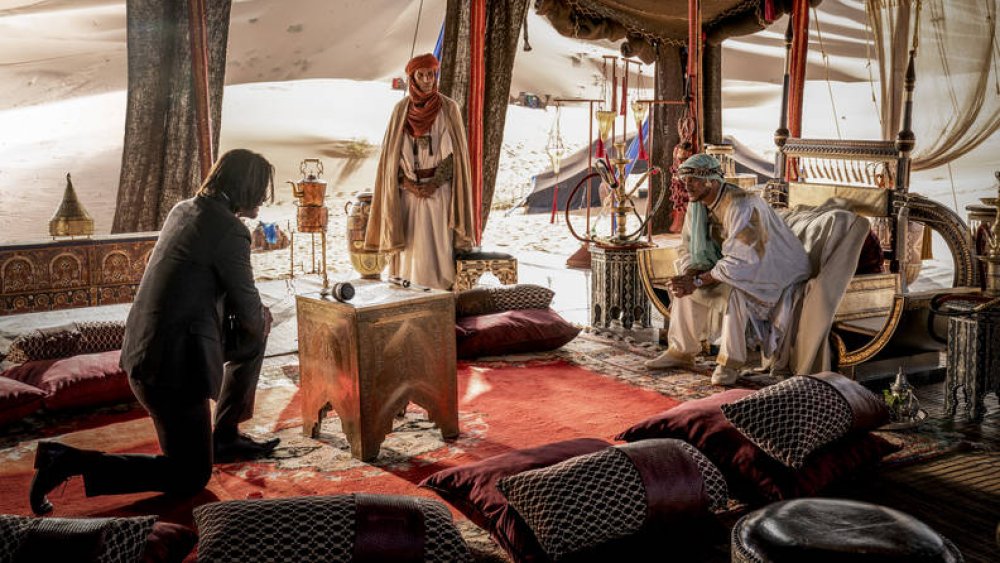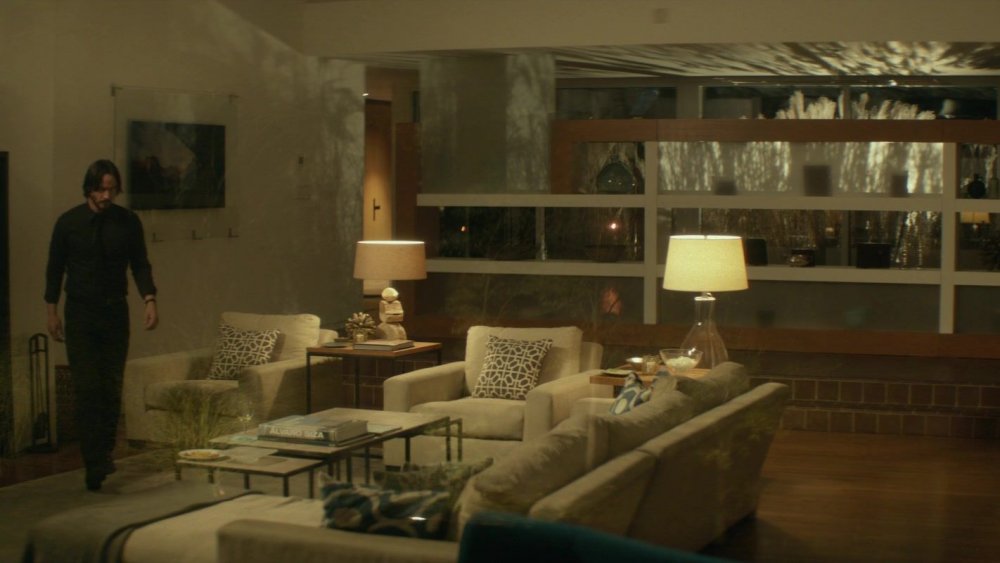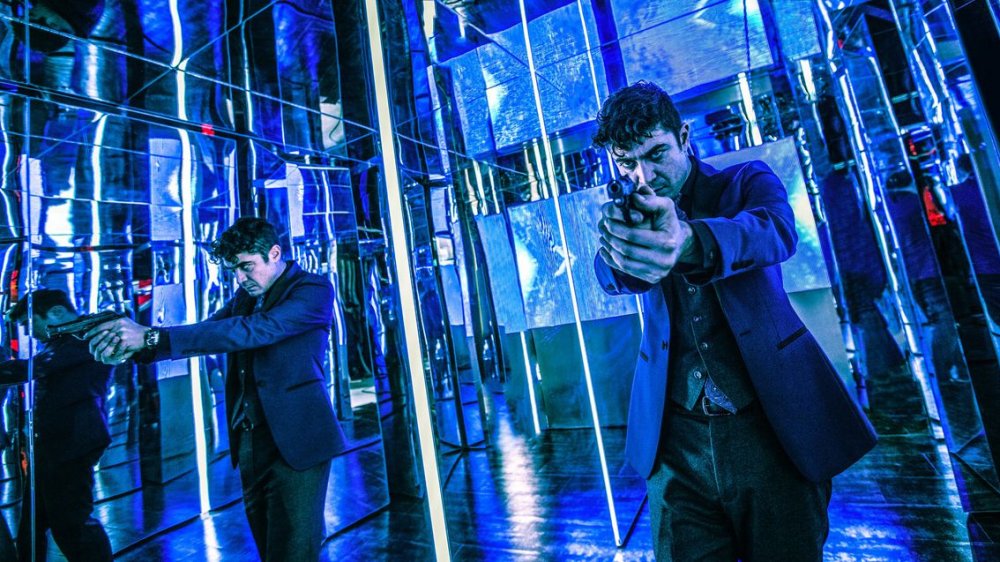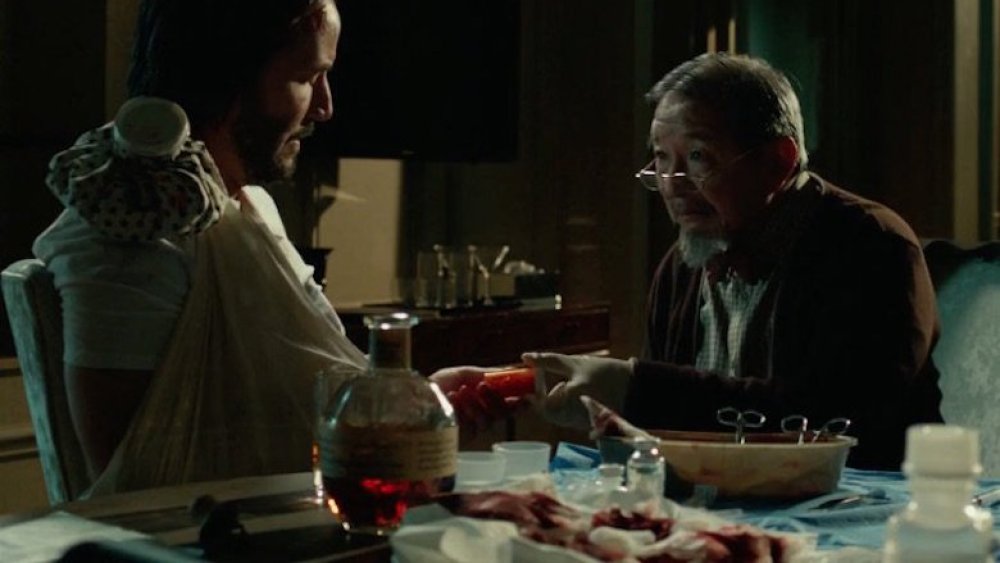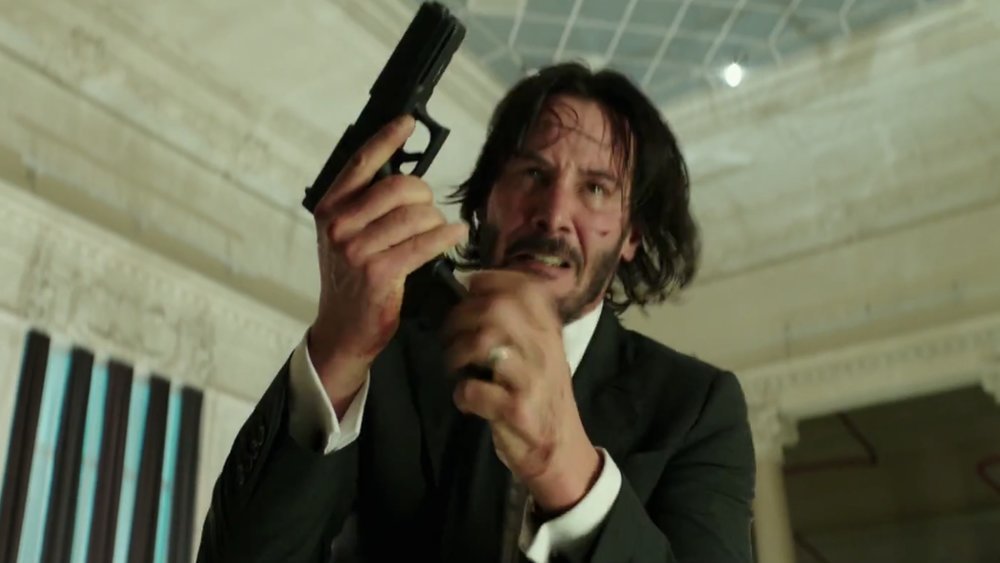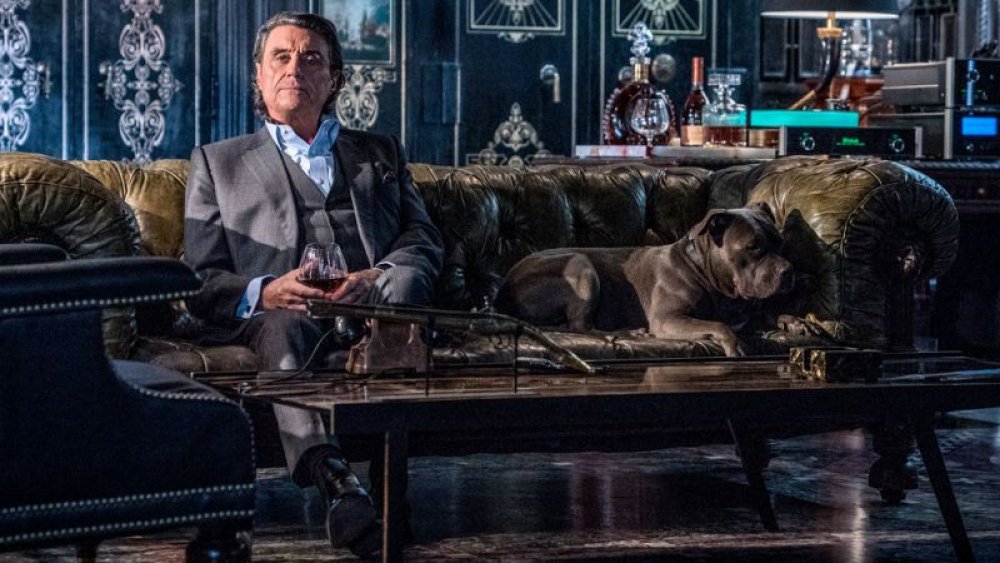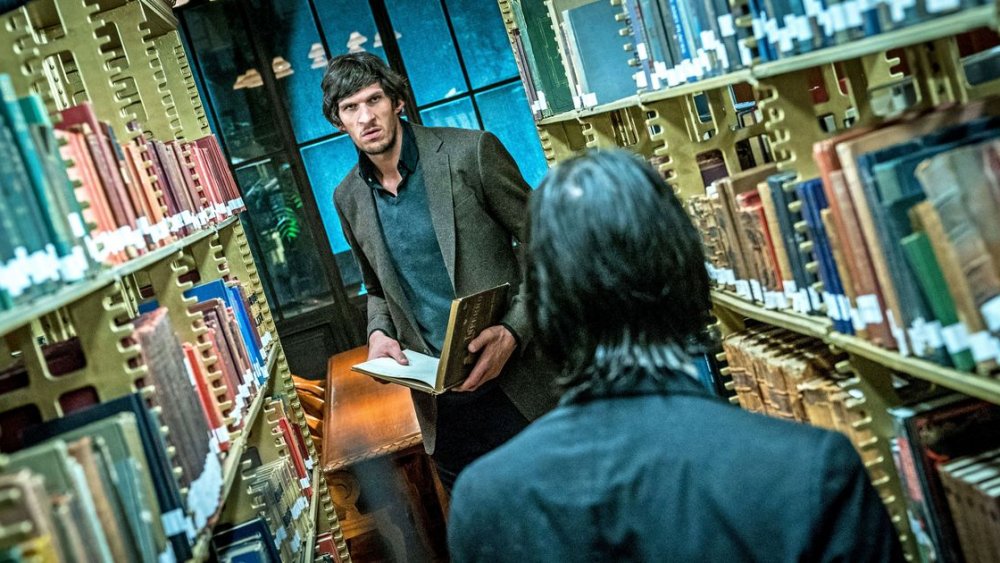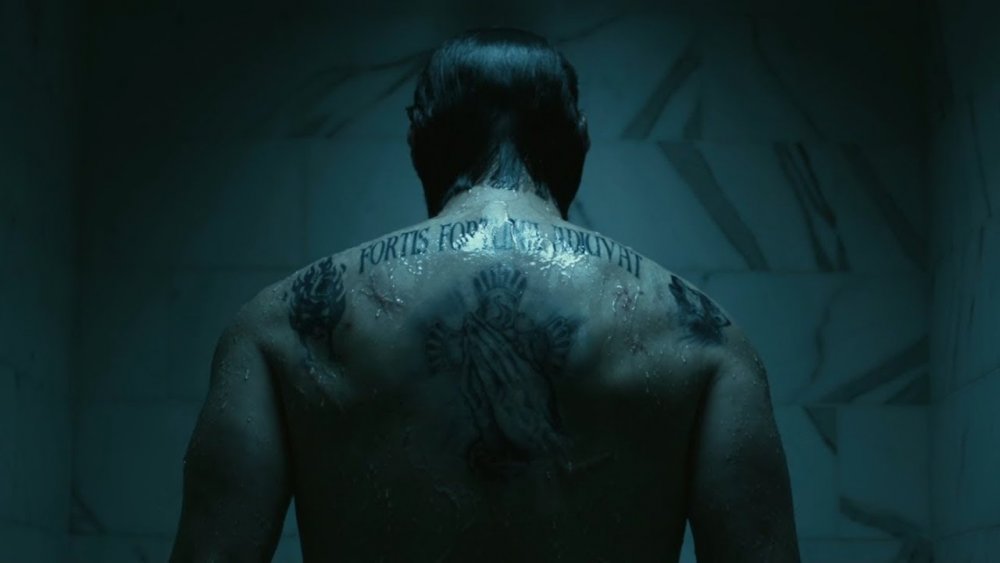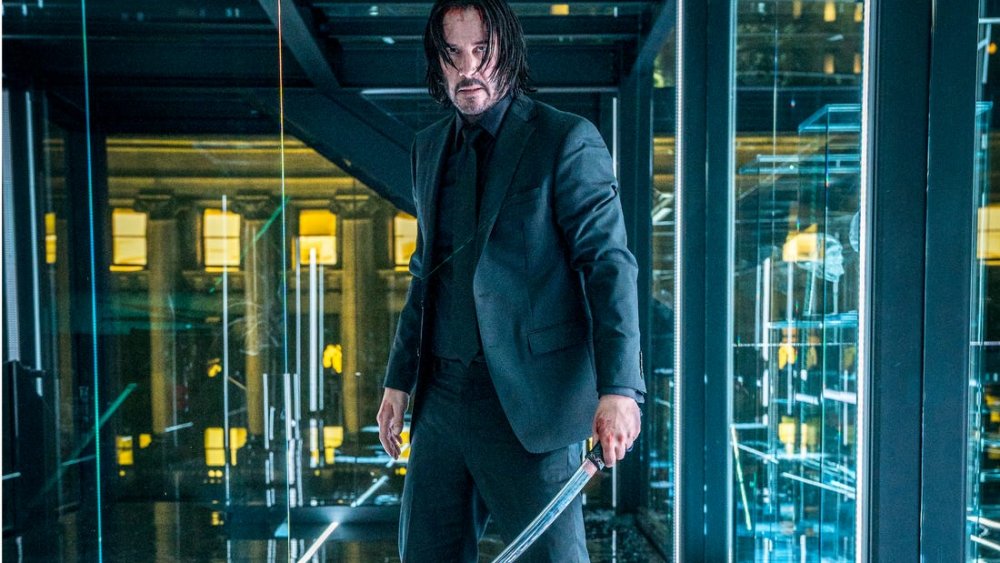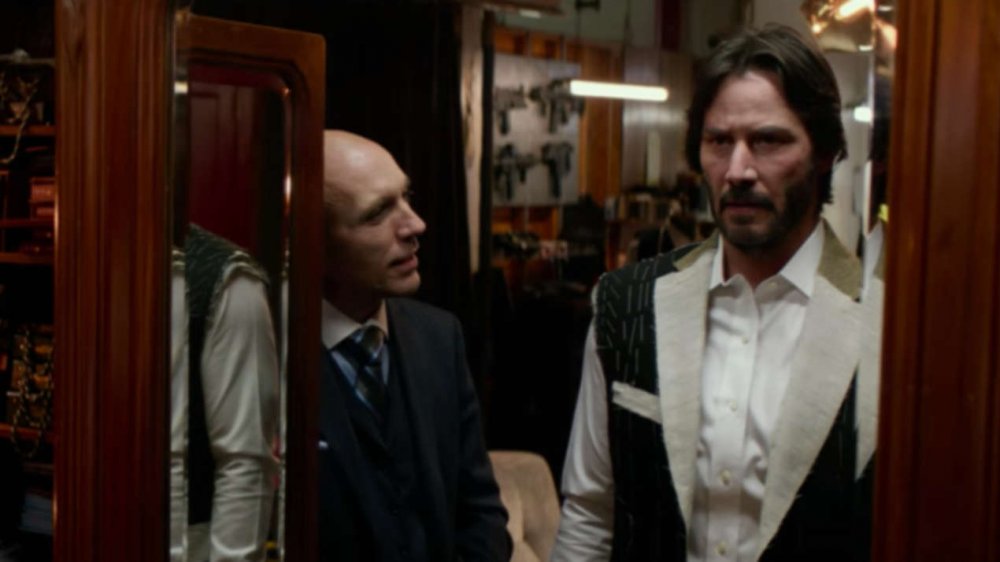The Real-Life Inspirations Behind Everything In The John Wick Universe
When John Wick was released, audiences were surprised to learn that the story was original, not based on even an obscure comic book or graphic novel. Created by Chad Stahelski and David Leitch and written by Derek Kolstad, the high-powered underworld thriller featuring Keanu Reeves as one of the deadliest assassins known to man feels as removed from reality as most action franchises. With John Wick's extraordinary fighting and healing abilities as well as constant death-defying stunts, John might as well be considered a superhero for all that he is incredibly able to accomplish.
But the Wickiverse is heavily rooted in actual people, places, and things — which is likely one of the reasons the franchise has resonated so deeply even with audiences who don't normally go for car chases or gun-fu fighting amid the ever-deepening world building of the High Table and beyond. From John's own background to the stupendous fight choreography, here are the real-life inspirations behind everything in the John Wick universe.
The Ruska Roma are a real people
While John Wick star Keanu Reeves is a multiracial Asian man and his in-movie adopted mother the Director (Anjelica Houston) is ethnically white in real life, in John Wick Chapter 3 we find out they are both members of the Ruska Roma, a reference to an actual Romani clan in Russia that numbers roughly 209,000 people. Because of rampant discrimination against the Ruska Roma, the Russian government refuses to issue them passports so they cannot legally escape systemic terrible work and living conditions that lead to exploitation and incarceration.
Ruska Roma babies are often refused birth certificates, which in many ways makes them a stateless people in spite of being confined within Russia's borders. In the Wickiverse, this background of the Ruska Roma is echoed, as the Director had to smuggle young Jardani Jovanovich out of Belarus and secrete him away in the Institute where he began his training as a boy. The Ruska Roma are also a matrilineal society, which further explains why the Director would be a woman.
The Continental is modeled after Switzerland's perceived neutrality
In each John Wick installment we spend time in the Continental, a hotel and meeting center for the underworld of the High Table with headquarters in New York City, Rome, and Casablanca (that we know of so far). The Continental has one simple rule, "No business conducted on Continental grounds," which translates to no killing allowed when on Continental property. According to John Wick writer Derek Kolstad, this neutral space was based on the real-life country of Switzerland and its non-political status in the region and in particular during times of war.
Kolstad told Polygon, "I loved those noir-ish movies where you had East Germany and West Germany, you had the two different agents, but as soon as they're in Switzerland, it's like, 'Well, all right, let's get a drink.'" We see this exact scenario play out in Rome between John and Cassian (Common) who are in a knock-down drag-em-out brawl that lands them through a Continental window. Following the rules, they dust themselves off and have a whiskey at the bar, continuing their fight once they're off the Continental Rome's palatial grounds.
The Continental's Operators look was inspired by Suicide Girls and analog technology
For a high-tech assassin and criminal underworld that has John Wick and company suited up in weapons-grade materials with a plethora of the most efficient killing machines at hand, the reveal that the Continental's administrative Switchboard uses paper, rubber stamps, chalkboards, and old-fashioned Telex machines is jarring at first. The enigmatic Operators are all also dressed like '50s pinup girls in matching pink shirts and black skirts, and everyone is heavily tattooed in a popular rockabilly style.
According to writer Kolstad, the Operators were inspired by the Suicide Girls, an early 2000s community of alternative pinup models and performance artists who broke the traditional mold of that genre with their unique tattoos and all body types represented. While we don't know much about these enigmatic office workers and how they fell into this unique role within the Wickiverse's underground, their upcycled vintage charm adds a whole new level of reality to the fictional universe.
The High Table was modeled after feudalism
Up until the 17th century in Europe, the political, social, and cultural system of feudalism marked how most people lived and organized in a given area. A fief was a plot of land that was entrusted to a subject by the owner in exchange for the subject's loyalty, who tended the property in exchange for protection by the much wealthier and powerful owner. These feudal systems were rife with corruption and exploitation, and were summarily dismantled beginning in the mid-1600s in exchange for more representative-based governing systems.
In the John Wick universe, this same medieval system of feudalism inspires the High Table and its functionality. The High Table has its ruling class around the world, and people like John Wick and his assassin colleagues the Adjudicator (Asia Kate Dillon), Aurelio (John Leguizamo), and the Continental's concierge Charon (Lance Reddick) all serve those respective "lords." As with feudalism, there is only one entity bigger than the High Table in John Wick: The Elder, who corresponds to the monarch in medieval feudalism. Also, the High Table is challenged in the John Wick films, just as feudalism eventually was in real life. The coins and markers seen throughout the franchise are considered part of this feudal social contract, as well as being something of a business card.
Minimalism also shapes aspects of the Wickiverse
Minimalism was a style of art and architecture first emerging in the 1960s that broke from the more elaborate styles that came before. As its name implies, minimalism has a "less is more" aesthetic that relies on clean lines, bold looks, and strategic use of color for maximum effect. When it comes to minimalism in the John Wick movies, director Chad Stahelski told Complex: "The shots are simple. It's all about the character and you see what he's going through, but it's also about the pauses, the uncomfortable silences. Not cramming a character's story down someone's throat." In the same interview, screenwriter Derek Kolstad went further, saying, "We're stripping out a lot of the story and just making it about the character. I mean, it's called John Wick — it's really about this guy's very simple journey. We just didn't want to clutter it. It's gratifying it in its own right, in its simplicity."
In this same minimalist vein, John and Helen's house itself ended up informing John's own character and psychology. Located in an undisclosed location in upstate New York, the real-life house where John's home scenes were filmed in many ways perfectly encapsulates the minimalism of the John Wick franchise. Designed by modernist architect Alvario Siza, John's house features amazing natural light, sleek lines, elegant furnishings, and most importantly privacy. So far, minimalism has been incredibly effective in keeping audiences riveted to the John Wick series.
The many pop culture inspirations for the John Wick franchise
From Sergio Leone's so-called spaghetti westerns to a plethora of martial arts films, creators David Leitch and Chad Stahelski have noted their personal obsession with the action films of the '60s and '70s, in particular Point Blank. They were also inspired by comic book aesthetics, which is why the production design often looks like a shifting watercolor painting. Writer Derek Kolstad credits author Alistair Maclean for world-building inspiration, and Stephen King for illustrating the lengths that a person will go to on the worst day (or days) of their lives.
Charles Dickens' Oliver Twist gets credit for John Wick's origin story at the Institute, as well as the Bowery King (Lawrence Fishburne) who was modeled after professional pickpocket Charles Fagin. And Chad Stahelski found surprising influence in 1952's Singin' in the Rain when it came time to choreograph fight scenes.
Since Stahelski was one of Bruce Lee's students as well as a good friend of his son Brandon, Stahelski of course credits Lee's impact on him both personally and professionally. The mirror scene in John Wick: Chapter 2 is a direct homage to Lee's iconic fight scene in Enter the Dragon. Akira Kurosawa's samurai aesthetic plays a huge part in the Wickiverse, and so does Jackie Chan, as like Chan, Keanu Reeves does virtually all his own Wick stunts.
The expansive world-building was inspired by the Wachowskis
How did a first-time director like Chad Stahelski land one of the world's top talents for his debut with John Wick? The answer is Matrix franchise masterminds the Wachowskis. Stahelski had been Reeves' stunt double for the majority of the Matrix movies and through working together for so many years, they became friends as well as colleagues. John Wick co-director David Leitch also worked as a stunt double on the Matrix set.
But Stahelski also learned about how to build a world from working on The Matrix, too, and he credits this experience with his ability now to create the John Wick universe. Stahelski tells Esquire: "To spend a year of my life with the Wachowskis, and to see how they make film, was a life-changing event. For most of how I made John Wick, and most of how I direct, it's pure Wachowskis — their attention to detail. To sit back and watch them work was the Harvard of film school."
But the Wachowski connection doesn't end there. John Wick's Bowery King is played by Lawrence Fishburne, who played Morpheus in the Matrix movies, bringing Reeves and Fishburne together for the first time since their work on that franchise. Also, Randall Duk-Kim, the Keymaker from Matrix Reloaded, plays the sympathetic doctor who helps John in John Wick and John Wick: Chapter 3 – Parabellum.
The messiness of real-life fighting shows up in John Wick
From its production design to extensive worldbuilding, there is so much that sets the John Wick franchise apart from other action movies. But when it comes to the fight scenes in particular, Chad Stahelski has opted for a much higher level of realism than many other action films. For example, most action flicks don't show weapons reloading in real time or include the occasional take in which a stunt doesn't go as planned. Take the scene in Parabellum when John throws the antique hunting knife and it doesn't actually land. Talking to Exclaim, Stahelski said these are simply the kinds of things that happen with even the most experienced stunt crew, which makes what they're doing in John Wick much closer to real life.
Another onscreen trick that action fans will have noticed is how often John Wick reloads his guns. Stahelski says that this factor of real-life gunplay often gets left out of movies because it can look hokey on film. But because Keanu Reeves is such an arms master at this point, he's actually able to reload his guns quickly enough to incorporate the action as part of the choreography.
Mythology connections in John Wick
Joseph Campbell was a professor of mythology and literature whose academic work revolved around what we now call "the hero's journey" as well as the notion of monomyths, the idea that all mythology in the world comes from a shared point of human experience. Being a fan of Campbell's theories, Chad Stahelski decided to channel these universal mythological underpinnings into the story and psychology of the John Wick franchise.
Talking to Thrillist, Stahelski noted that New York's Continental manager, Winston (Ian McShane), is representative of the god of the underworld Hades, which also explains why the concierge is named Charon — Charon was Hades' right-hand man who brought the dead across the River Styx to their new home. John Wick himself represents a number of different Greco-Roman figures such as Orpheus and Odysseus, Achilles, and eventually Hercules as he battles bigger and bigger foes.
Arthurian legends also come into play here; Stahelski and writer Kolstad explore the notion of chivalry and how this relates to the idea of "honor among thieves" that we see in John Wick's universe, as well as the Round Table where Arthur and his soldiers meet to organize.
The library fight in Parabellum was inspired by the New York Public Library where it takes place
As the John Wick universe has revealed more of its secrets, we've learned that John had more than one hiding place for the gold coins, markers, and weapons underneath his house. In Chapter 2, John opens up a security box tucked away in a jewelry store and diamond exchange. And in Chapter 3, John has Sofia Al-Azwar's (Halle Berry) marker stashed in a book of Russian fairy tales at the New York Public Library, along with one of the last remaining photographs of his wife Helen. Even though the John Wick franchise continues to push the envelope when it comes to fight scenes, it was still a surprising move that John would battle a giant assassin (played by basketball star Boban Marjanovic) right there in the crowded book stacks — another homage to Bruce Lee, specifically his fight with Kareem Abdul-Jabbar in Game of Death.
Funnily, the New York Public Library itself inspired this unusual scene. Doing research, Chad Stahelski found himself in a remote corner of the library. As he looked around it occurred to him it would be an excellent spot for a fight scene, and so they made it happen for John Wick: Chapter 3 – Parabellum.
Aside from the library, the city of New York was huge inspiration for Stahelski all by itself. Likening it to the world created in Men in Black, Stahelski noted that New York really does feel like a place with a plausible underworld just under everyone's feet.
The tattoos are loaded with real-life symbolism
VIrtually every aspect of the John Wick franchise has been selected by the creative team to add to the growing mythology of the High Table and its underworld. This fact applies as well to the variety of tattoos shown onscreen, especially those worn by John and the members of the ballet Institute where he was raised.
For example, the praying hands in the center of John's back are based on Albrecht Dürer's "Study of the Hands of an Apostle," which signifies loyalty in the Wickiverse as well as doubling as a "ticket" that saves his life from the huge bounty placed by the High Table. The wolf on John's left shoulder is Cerberus, the guard dog of hell, and the one on the right is a traditional Russian tattoo that goes along with the Russian Orthodox cross sported by all of the ballerinas at the Institute. "Fortis Fortuna Adiuvat," written across John's back, means something along the lines of "Fortune Saves the Strong," which sums up Wick's story and character in just a few words.
The influence of Chinese wuxia films and mythology on John Wick
John Wick truly has global inspirations thanks to Chad Stahelski and his team, and another specific mythology that informs the franchise is the influence of Chinese wuxia films. This is thanks in particular to Chinese director John Woo, who elevated action films into fight operas with incredible cinematography, color design, and intense plots with a great deal of humanity, influencing subsequent wuxia classics like Ang Lee's Crouching Tiger, Hidden Dragon.
Relating to Joseph Campbell's idea of the monomyth and dating back to the Qing dynasty, wuxia stories revolve around a wandering warrior who helps put-upon regular folks in need, often through defeating a more powerful member of society who is exploiting or abusing commoners. Coining the phrase "gun-fu" to describe one of the fighting styles often used in John Wick, Stahelski has blended influences from around the world to create a singular universe that simultaneously relies on ancient storytelling methods while creating something new.
The influence of Western ballet on the John Wick franchise also folds perfectly into the wuxia style of action filmmaking.
John Wick's suit is almost its own character thanks to the designer
The John Wick universe has revealed itself in small doses over the course of three movies, and it's in Chapter 2 that we find out part of John's extraordinary power is partially due to a turbo-charged suit that also includes bulletproof "tactical" lining. About his work, tailor Luca Mosca told Gentleman's Journal, "I am generally hired to design the outfits and costumes for films with sleek characters... Roles that need to convey extreme elegance."
Just as John Wick needs special lining in his suits that won't disrupt the lines of the fabric and cut, so too does Keanu Reeves need room in the suit lining for padding and other protective gear, as the majority of his fight scenes take place in those suits. As Mosca details his design process, it's no small feat to get Reeves to look like he's fighting as effortlessly as he does in the suits, making them almost their own characters in the Wickiverse. Mosca himself even makes a cameo in Chapter 2 as the tailor who outfits John Wick in Rome.
